After years of neglect, there have been encouraging signs in the past couple of months that the City's attitude toward pedestrian safety is starting to change. It needs to change faster.
By Ryan McGreal
Published July 17, 2013
In the past couple of months, Public Works crews have been bolstering pedestrian crosswalks at various intersections across Hamilton. In the past month, this has included zebra crossings at several locations.
Zebra crossings are crosswalks defined by alternating bars of white and asphalt, which increase the visibility of the pedestrian crossing.
A new Zebra crossing marks the intersection of Locke Street and Hunter Street:
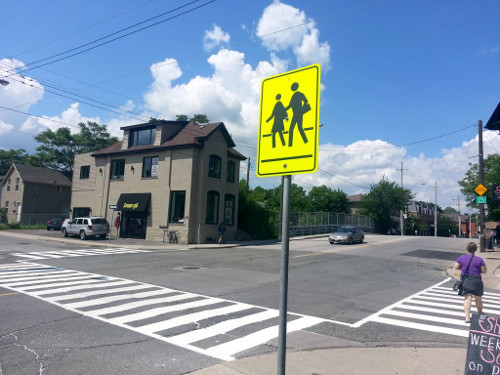
Zebra crossing at Locke and Hunter (RTH file photo)
The intersection is not signalized and there is no stop sign for drivers on Locke, though it is patrolled by a crossing guard during the school year. However, the City is reviewing the intersection and looking into the possibility of "additional or enhanced signing".
One possibility would be a flashing light similar to the intersection of Locke and Herkimer, which was recently upgraded with zebra crossings and bumpouts after an act of tactical urbanism in May.
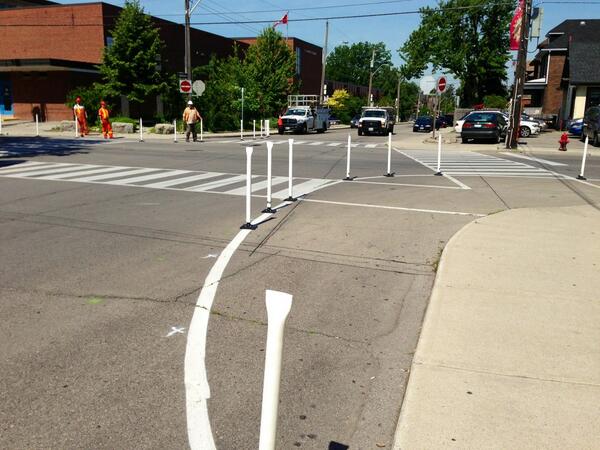
Bumpouts, knockdown sticks and Zebra crossings at Herkimer and Locke (RTH file photo)
Architect Graham McNally, who was one of the organizers of the Tactical Urbanism workshop and lecture in May, just posted a photo of a new zebra crossing at Aberdeen and Dundurn on twitter.
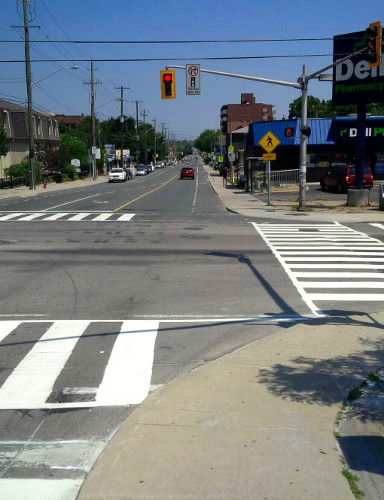
Zebra crossing at Aberdeen and Dundurn (Image Credit: Graham McNally)
McNally wrote, "The effects of tactical urbanism continue to spread!"
The intersection at Aberdeen and Dundurn is particularly difficult for pedestrians because of high vehicle traffic volumes and an awkward three-stage traffic light cycle that can leave pedestrians cooling their heels for a long time.
This is further complicated by the removal of the sidewalk on the southwest corner during construction of the new Urban West Condo development at 427 Aberdeen Avenue.
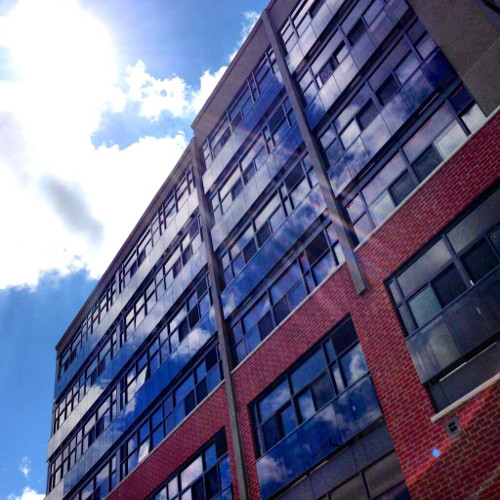
427 Aberdeen Avenue (Image Credit: Jason Leach)
The City is also installing zebra crossings at Upper Gage and Fennell and Upper Gage and Mohawk. Another twitter user, @danielacts1, recently shared a photo of the zebra crossing at Upper Gage and Mohawk:

Zebra crossing at Upper Gage and Mohawk (Image Credit: danielacts1 on twitter)
This is the intersection where an 83-year-old pedestrian was killed after a collision with an automobile on May 25.
As the Ontario Coroner reminds us, young children and senior citizens are the most vulnerable road users, and streets should be designed to be safe for everyone.
Historically, the City has been deeply reluctant to invest in pedestrian-friendly infrastructure where such investment might interfere with the fast, unimpeded flow of automobile traffic. Just last December, an 87-year-old pedestrian was killed on Governer's Road at the very location where hundreds of residents had signed a petition calling for a crosswalk. Dundas Councillor Russ Powers had responded to the petition by saying the street was due to be renovated in 2017.
There have been encouraging signs in the past couple of months that the City's attitude toward streets designed to accommodate pedestrians is starting to change.
John Mater, director of corporate assets and strategic planning for the City of Hamilton, explained in an email that the staff are "looking at this issue in terms of where and under what criteria we should consider" zebra crossings.
He added, "There is a lot of pent up demand, they are marginally more expensive than regular markings and as you know we are playing a bit of a catch up here."
Staff "do support the use of these markings in more locations" but are reluctant to adopt zebra crossings as a standard for all intersections. Again, according to Mater:
Traffic Situations and problems are dynamic and changing, and what might be an appropriate use of a measure somewhere could be a very inappropriate use of the same measure somewhere else. From a technical perspective, the first challenge for us is to try to identify the problem and then design an appropriate plan for response. Once we lock down a standard, it may become difficult to do this properly, but things like zebra crossings should and will absolutely be a tool in our traffic toolbox.
One thing is clear: the more safe, welcoming and accessible the city makes its streets for pedestrians, the more people will walk. After public works staff installed a button-activated crosswalk at Aberdeen and Kent last year, pedestrian use more than tripled.
Unfortunately, even now we are missing great opportunities to make more substantial improvements to walkability and bikeability on Hamilton streets.
The city just repainted the existing vehicle lanes on King Street instead of adding a protected bike lane at effectively zero cost. This is despite the fact that King has significant excess lane capacity - even during rush hour, there were no significant slowdowns during the roadwork.

King East between Steven and Ashley (Image Credit: Laura Farr)

King East between Sanford and Wentworth during rush hour (Image Credit: Bob Berberick)
Likewise, the city is not installing any cycling infrastructure on Barton Street between Centennial Parkway and Nash Road after it installs a new water main and reconstructs the traffic lanes, sidewalks and curbs.
According to Kelly Anderson, spokesperson for Public Works, the city was constrained by "the relocation of utilities and poles" and "property constraints and a nearby cemetery" that would interfere with "widening the road in this area to accommodate bike lanes."
Once again, the City is only prepared to add pedestrian or cycling infrastructure where that does not interfere with existing automobile traffic flow.
On the other hand, the City is counting down the days until August 12, when most North End Neighbourhood streets switch to 30 km/h speed limits. The North End Neighbourhood negotiated a 30 km/h neighbourhood limit as part of the North End Traffic Management Plan.
The speed limit will be enforced through design with bumpouts, curb extensions, enhanced crosswalks, lane narrowing and curbside parking, as well as posted speed limits.
The City also recently converted MacNab Street to two-way between Cannon and Burlington Street, in part to facilitate an alternate route to the waterfront during the replacement of the Bay Street North bridge over the CN railway.
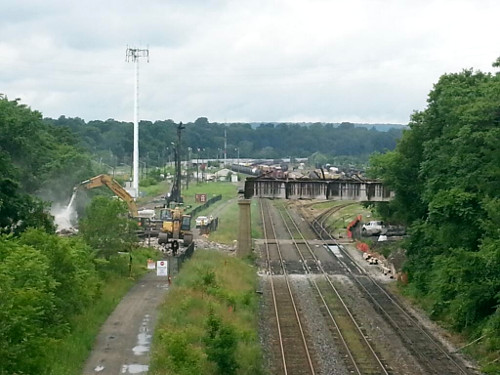
Bay Street North bridge replacement in progress (RTH file photo)
The NEN lost an Ontario Municipal Board (OMB) appeal to extend the speed reduction to James Street North and Burlington Street, and Council only approved the reduction as a five-year pilot, during which time other neighbourhoods will not be granted a 30 km/h speed limit.
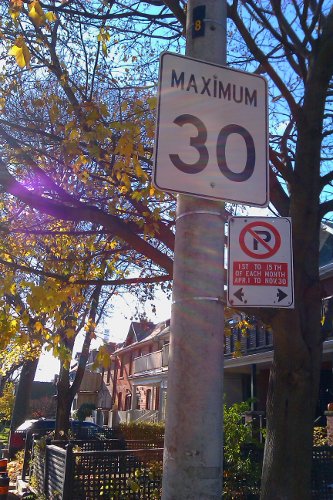
30 km/h speed limit in Toronto's Beaches neighbourhood (RTH file photo)
Cities across North America and Europe are moving to 30 km/h speed limits on urban residential streets on the recognition that the risk of pedestrian injury or death in a collision with a vehicle rises exponentially with the speed of the vehicle (according to the formula KE = 1/2mv2).
Between 30 km/h and 60 km/h, the kinetic energy of a motor vehicle roughly quadruples. For example, a Honda Civic has 40,937 Joules of kinetic energy at 30 km/h but 163,750 Joules at 60 km/h.
Similarly, the stopping distance also roughly quadruples. Again, in the example of a Honda Civic on dry asphalt, the approximate stopping distance increases from 20 metres at 30 km/h to 70 metres at 60 km/h.
The danger thus increases on two dimensions: a faster vehicle is both exponentially more likely to collide with a pedestrian and exponentially more likely to injure or kill that pedestrian.
This is why David McKeown, Toronto's medical officer of health, called speed limits a public health issue in a 2012 report (notwithstanding the spluttering incredulity of Toronto Mayor Rob Ford).
It's why London has reported a 46 percent drop in deaths and major injuries in its 30 km/h speed zones since speeds were reduced.
Five years is too long for Hamilton to consider extending the benefits of slow, calm, safe streets to more neighbourhoods.
By kdslote (registered) | Posted July 17, 2013 at 16:02:27
There's also work going on at the intersection of Herkimer and Caroline. I'm hoping this is the long-promised pedestrian activated light. The stretch of Herkimer east of the on-ramp style intersection at Queen is quite a dangerous drag strip, not interrupted until the lights at Bay - lights at Caroline will break it up nicely!
By kevlahan (registered) | Posted July 17, 2013 at 16:36:13
Five years!? That is an incredibly long period for a pilot project, especially since it is being used as an excuse not to allow any other 30km/h zones.
One year should be more than sufficient to determine whether there are any serious problems (which I doubt). Is there continuous monitoring? If the City really does want to treat this as a long-term pilot project, they need regular monitoring and should make changes to try to correct any issues. For example, if speeding is a problem, is the City open to making engineering changes (e.g. bump-outs, speed humps or chicanes) during the pilot period? The goal should be a to make 30km/h a success, not to look for reasons why it can't work. Continuous small improvements is the way to make progress, a five-year cycle is far too slow.
30km/h shouldn't be controversial, at least on non-arterial streets. It is the standard "school zone" and "playground zone" limit in western Canada and is being widely adopted throughout the EU.
Comment edited by kevlahan on 2013-07-17 16:46:56
By Doc Brown (anonymous) | Posted July 17, 2013 at 18:28:12 in reply to Comment 90251
The economic driver of not only the city, but the province (if not the country) is just around the corner from the north end. The huge steel companies and the medium sized industries surrounding them employ hundreds of thousands of people and need to get their products out to the rest of the continent as fast as possible. The rest of the city needs to realize that the swift movement of workers and goods into and out of that area simply must take precedence over neighbourhood niceties like "safety" and "quality of life". If they don't like it, they can work harder to earn the money to move to a sleepy town like Toronto where there is no economic activity, and can therefore afford the time and space to have calm streets in the neighbourhoods in and around their core.
By Anon (anonymous) | Posted July 17, 2013 at 20:06:44 in reply to Comment 90255
I can't tell if the tone of this comment is sarcastic or serious. What do we do with poor people, who cannot afford to move to sleepier towns? To quote the road poetry on Locke St., the mind moves three miles an hour. Get some guts to stand in the midst of traffic, effectively blockading, until avoidable pedestrian deaths are addressed. Speeding is a failed attempt to save time, and I could see its allowance only in cases of emergency.
By rednic (registered) | Posted July 17, 2013 at 22:15:11
Well ... once again ward 3 loses out. For a ward full of absentee landlords and councillors I for one am not the least bit surprised.
I can hardly wait until 2015, then I can read al these articles in South American newspapers about canada's inner city slums.
Ward 3 needs leadership Not absenteeism. If your so sick and can't make it to work for six months RESIGN you have a pension.
This issue is effecting ALL of hamilton. Morelli's absence has basically allowed Declair to take control of the police board, so he can get his budget thru.
But since the councilor is non resident a fast commute is really the best thing he can get from the ward. SO even if he wasn't sick, things wouldn't change.
Comment edited by rednic on 2013-07-17 22:17:03
By Rimshot (anonymous) | Posted July 18, 2013 at 10:49:33
Given the fast-tracking of Locke/Herkimer and Locke/Hunter, maybe neighbourhoods-in-need should consider taking on Kirkendall's Messrs Toms and MacNally as tactical-urbanists in residence.
By JoltinJo (anonymous) | Posted July 19, 2013 at 13:52:19
Zebra crossings I get - flashing lights at pedestrian crossings - also helpful to drivers who might not spot the pedestrian trying to cross. The bumpouts at Herkimer and Locke - RIDICULOUS! Who thought that up?
Seriously? Oh and by the way - pedestrians - you gotta look before you cross. As a driver, I am careful and responsible and pedestrains have to be too.
A word to author Ryan McGreal. A bike lane on King Street in its current 5 lane one way structure would be bike suicide....if they want to a) increase pedestrian business on that street and b) make it bike friendly then let's go 2 way with parking on one side....and by the way - there are plenty of slowdowns on King street during the resurfacing - you gotta get out more!
Finally a word about the new lights at Caroline and Herkimer. The city has got to decide if an area is residential or commercial - first they allow a conveniece store and a drug store - then they are surprised that people are parking outside of the stores and crossing the street to get there? Are they are surprised that drivers are using a one way street like Herkimer at speed? Really? Make it a 2 way street with speed bumps -- you stop the speed!
By Fred Street (anonymous) | Posted July 23, 2013 at 07:13:00 in reply to Comment 90283
Toggle-bollard bumpouts are far cheaper than extending the sidewalk, and much less permanent. In a city as risk-averse and auto-deferential as Hamilton, those considerations make all the difference.
By Robert D (anonymous) | Posted July 19, 2013 at 22:32:33
Queensdale Avenue between Upper Wellington and Upper Wentworth was just repainted to have two bike lanes, one lane of traffic each direction, and parking on the north side of the street.
It's quite a change from the former one lane of traffic in each direction and parking on both sides of the street.
What bothers me though is the pedestrian crossings. There are two stop signs along that stretch of Queensdale, and neither has any crosswalk markings at all. One is across from inch park, the other is at East 13th near two bus stops.
They used to have painted crosswalks (two simple white lines) at both of these intersections, but let them fade a number of years ago and never repainted them. Since people often pretend not to see the stop signs, I wouldn't mind having markings on the road to serve as a further visual reminder that these intersections are different than the rest.
You must be logged in to comment.
There are no upcoming events right now.
Why not post one?